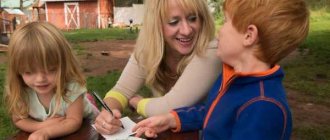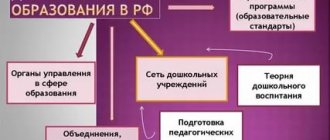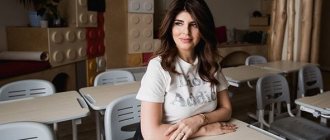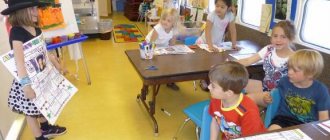Today there are a huge number of different development methods and systems, including non-standard ones, for preschool development and upbringing of a child. Every year - more and more. It is not surprising that this causes a mixed reaction among professionals: there is a Federal State Educational Standard, there are programs, what other “lettergrams” and “spiritual approach to the development of a child’s free personality”? There is definitely a subject for debate. Our expert Marina Bolotova, the scientific director of preschool educational organizations, has carefully studied many popular and original modern methods due to her work. This article is a specialist’s answers to the TOP 5 alternatives to the classical approach. So as not to miss the important things behind the emotions.
All the methods we talk about in this article are focused on the environmental approach: the child is in a specially organized environment that best satisfies the child’s needs.
Montessori pedagogy
Technology invented by teacher Maria Montessori. Initially, she conceived the approach to work with “special” children, but then transferred it to everyone else. The main idea of the approach is that every child has a powerful potential for development; you just need to create conditions using a special environment and not disturb the child.
What principles does it work on?
- A special environment is created, divided into five zones. Practical for the development of everyday skills, sensory with toys of different shapes, sizes, colors, mathematical for the development of counting skills and familiarity with geometric shapes and symbols, language zone for learning letters and syllables, space zone for getting to know the outside world and the mysteries of nature.
- Classes are held in different age groups. Older children interact with younger ones: they pass on their skills to the younger ones and not only teach them, but also develop their skills even better.
- Teachers do not impose or forbid anything on the child - he makes the choice to play with dolls, draw or jump and run. The teacher only presents the material and reveals it as much as possible.
What goals does the child achieve?
- Learns independence. Free choice of activities also develops self-confidence and self-confidence.
- Learns to respect others. Children work and play quietly to respect the time and space of others. You can let off steam in a special “motor” zone. Children also clean up toys after themselves and follow the principle “whoever takes it first gets to play.”
- He studies mathematics, learns about nature and culture. This is helped by working in different zones.
- The teacher must respect children and their choice: give them the opportunity to play and choose the pace of classes.
- The teacher must be able to create an environment. Many toys are made by hand from natural materials.
- The teacher must be able to captivate children. It is he who presents materials for games and activities, and he serves as a model in group creative activities.
Master class “Application of innovative technologies in working with preschool children”
GKKP Kindergarten "Zhuravushka" of the akimat of the city of Kurchatov"
“Application of innovative technologies in working with preschool children”
Speech at city pedagogical readings
Master Class
Application of innovative technologies in working with preschool children through the development of logical thinking
2020
The purpose of innovative technologies:
creating an integrated approach to the development of a child’s intelligence through the introduction of a system of modern educational gaming technologies.
Objectives:
1. Development of a child’s cognitive interest, desire and need to learn new things. 2. Development of observation, research approach to phenomena and objects of the surrounding reality. 3. Harmonious, balanced development of emotional, figurative and logical beginnings in children. 4 Formation of basic ideas (about the surrounding world, mathematical), speech skills. 5 Development of fine motor skills and all mental processes.
Expected results:
The creation and application of the educational system of games “Child and Game” in the educational process will help: - not only to form knowledge, skills and abilities in children, but, above all, to promote the intellectual and creative development of preschool children, - will contribute to the formation and development the creative potential of the teacher’s personality and his competencies - will increase the level of parental competence through familiarization with interesting options and new products in the field of educational games.
“A game is a huge bright window through which a life-giving stream of ideas and concepts about the surrounding world flows into the child’s spiritual world.” V.A. Sukhomlinsky The development of the intellectual abilities of preschool children is one of the pressing problems of our time. Preschoolers with developed intelligence remember material faster, are more confident in their abilities, adapt more easily to a new environment, and are better prepared for school. The use of educational games in the pedagogical process allows you to restructure educational activities: move from the usual activities with children to play activities organized by adults or independently, removes the excessive didactic nature of teaching, arouses interest in children, and a desire to engage in games. Among the author's educational games, we can especially highlight a group of innovative games that influence the development of intelligence: “Educational puzzle game “Tangram”, Game “Columbus Egg”, Didactic game “Geometric mosaic”, Game “Fold the square”, Lay out a picture from the figures, Didactic game “Colored figures-inserts”
Technologies:
When working with preschool children, I use technologies that are means of intellectual development. The technologies used are focused on the development of mental abilities, imagination and symbolic functions of consciousness of preschool children, which creates conditions for the rapid development of children's abilities. The peculiarity of technology is that I provide the maximum degree of freedom to the child, organizing a space equipped with educational games, attracting children’s attention to the games by my own example, and during the game the adult acts as a consultant, creating a situation of relaxed communication about tasks, problem situations, offered in the game. Technologies correspond to the principle of “developmental education”, and its implementation will allow building the learning process in the basics of mathematics in activities appropriate to the age of preschoolers - gaming, logical, cognitive and research, and will ensure continuity with the school in terms of content, forms and methods of implementation.
And now I would like to demonstrate to you several of these technologies, forms and methods of work used in my teaching activities.
Educational puzzle game "Tangram"
The game consists of several levels: parts of the tangrams need to be superimposed on the diagram itself; the child is given a diagram and he folds the figure on the table according to the model; the baby is given an outline of the image, and the baby must lay out the parts of the tangram along the outline; The child independently comes up with images and puts them together from tangram parts.
Game "Columbus Egg"
Tangram "Columbus Egg" is a puzzle consisting of ten flat figures that are folded in a certain way to obtain another, more complex figure.
The essence of the game
Designing on a plane various silhouettes resembling figures of animals, people, all kinds of household items, vehicles, as well as letters, numbers, flowers, etc.
Like the classic tangram, this game offers you to create numerous figures from ten parts. But, unlike a regular tangram, it has curved elements, which allows you to make the shapes you compose round.
Purpose of the game:
The game helps develop children's powers of observation, imaginative and logical thinking, spatial concepts, imagination, quick wit and ingenuity.
Children develop perseverance and the habit of mental work, and creativity is stimulated.
Didactic game "Geometric mosaic"
This is a very wonderful game that will help prepare children for school. After all, it will teach the child to navigate among geometric shapes, and will also develop perseverance, awaken a thirst for knowledge and stimulate cognitive activity.
Target:
— Develop visual-figurative thinking, creativity, memory, attention.
— Form sensory standards of color, size and shape, perception.
— Develop fine motor skills.
Material:
Multi-colored geometric shapes of different sizes and colors. Cards with drawings of geometric shapes.
Didactic games with counting sticks
Goal: development of logical thinking.
Objectives: - clarify knowledge of geometric figures, practice quantitative and ordinal counting
, comparing figures by size, laying out
silhouettes of geometric figures and objects counting sticks learn to solve logical problems involving the construction and transformation of images of geometric figures and objects; - develop attention, memory, logical thinking, fine motor skills; — to cultivate perseverance, interest in logical problems, the desire to independently cope with the task, and a feeling of joy from the results achieved.
Game "Fold the square"
Goal: -learn to fold squares based on different colors and shapes; - to develop in the child self-confidence, awareness that he can do something himself, and the joy of creativity
Post a picture of the shapes
Goal: developing children's ideas about geometric shapes
Objectives: Educational: create conditions for children to compare geometric
figures by shape
, color, and their designation by word;
Developmental
:
develop
thought processes: analysis, comparison and generalization.
Develop
children's
spatial understanding .
Develop visual
, auditory and tactile perception.
Didactic game
: «
Colored figures - inserts
»
Goal: Development of sensorimotor coordination of fingers and sensory representations in children.
Objectives: — To develop children’s knowledge about geometric shapes
and be able to name them (square, circle, triangle, oval, rectangle).
— Teach children to visually distinguish the shape of geometric shapes
and match the inserts to the frames.
By analyzing small mathematical problems, the child learns to navigate the world around him, take initiative, express his own position and accept someone else’s.
Thus, educational games help to cultivate children's cognitive interest, the ability to explore and creatively search, and expand their range of interests. Develop mental processes and speech in children.
Carrying out practical activities using entertaining material develops in children the ability to solve cognitive and intellectual problems, which contributes to the successful preparation of children for school.
The development of logical thinking is a very important and necessary process for children!
THANK YOU FOR YOUR ATTENTION!
Reggio pedagogy
Italian technology, based on the ideas of Vygotsky and Maria Montessori. The author of the technology is Loris Malaguzzi. Malaguzzi believed that the child had at least 100 languages, but 99 of them were stolen. Much in a child’s life happens at the direction of adults, even holidays. The main postulate is that the environment must meet the needs and capabilities of the child.
What principles does it work on?
- A separate program includes space for the child. He can even retire and do only what he wants.
- The parent is completely immersed in the work of the kindergarten. He sometimes goes to kindergarten with the child, helps, and becomes a partner.
- There is no assessment and control - no final tests. The Reggio teacher uses observation, records the results of the child’s work, but does not give an assessment.
What goals does the child achieve?
- Learns partnership. Children are taught to work in groups so that they learn to negotiate, cooperate, and get used to the fact that they are “not alone.”
- Studies culture. Classes are not limited to the kindergarten environment: children are taken on excursions, helped to understand relationships between people, the rules of society, and traditions.
- Learns free choice. The child himself chooses the pace of classes and the materials with which he will play.
What should a teacher be like?
The teacher must follow six rules:
- Respect the child and look him in the eye.
- Explain the rules and ask a question. Only this way, and not the other way around.
- Not “wrong”, but “different”.
- Offer choice and don't rush.
- Learn in any situation.
- Fantasizing is more important than reading.
Voskobovich games
Educational games created by physicist-engineer Vyacheslav Voskobovich. They represent a developing environment of different zones and elements, united by one fairy-tale plot.
What principles does it work on?
- It is based on three principles: interest, knowledge and creativity. This builds cognitive and research skills.
- Games are developed in accordance with the interests of the children. Each can be used by children from 2 to 7 years old; for younger children the tasks are simpler.
- The developmental environment “Purple Forest” has been developed for games, with several zones in which the child fulfills certain needs.
What goals does the child achieve?
The main goals of technology are learning new things, developing the ability to observe, building confidence, a harmonious approach to the development of emotionality, imaginative thinking and logic.
What should a teacher be like?
- The teacher must understand the material: know the games, be able to build a plot.
- The teacher must involve the children in the game; some time must be spent getting to know its rules.
- The teacher does not evaluate the completion of assignments. Each age has its own level; if you can’t cope, you can move on to an easier one.
Dewey technology
John Dewey developed a practice-oriented approach. Dewey believed that a preschooler should engage in play and work activities, which gives him the necessary life experience.
What principles does it work on?
- Everything that happens to a child must be practically oriented. There is no need to overload the brain with unnecessary knowledge; you need to teach how to work with your own hands, and apply acquired knowledge and skills in other situations.
- Education should be aimed at gaining experience, which can only be accumulated by the child himself. Thinking is only a tool for solving problems. The child explores the world around him and ultimately wants to learn the necessary skills and experience them.
- In addition to work skills, geography and history are important. Geography helps to learn about the world around us, history helps us learn about the world and culture of people.
What goals does the child achieve?
- Gains life experience. The child learns to solve problems and develops skills.
- He understands geography and history. This helps to understand the world around us and people with their relationships.
- Learns to be entrepreneurial. This is facilitated by the projects that the teacher launches with the children.
What should a teacher be like?
- Must have strong instrumental skills, such as working with hands. Without this, he will not teach the necessary skills to children.
- Does not compare children with a friend - competition is prohibited in technology. The child is compared only with himself.
- Teaches children project activities. Projects help children gain experience and learn skills, as well as collaborate with others and develop their own entrepreneurial spirit.
Combination of programs and technologies
In the education of preschool children, the greatest results are shown by the comprehensive use and integration in different versions of all modern technologies and programs. Experienced teachers and educators know this feature, so they try to combine them as much as possible in their teaching activities.
Different approaches are combined in one type of task, which allows not only to quickly gain knowledge and consolidate skills, but also to keep the student’s attention for the required time, which usually creates a problem in classes with preschoolers.
This direction is considered the most promising in the whole world, since it has repeatedly confirmed its effectiveness through practical experiments. In addition, with this approach, the risk of individual students with individual requirements “dropping out” from the general educational process is minimized.






